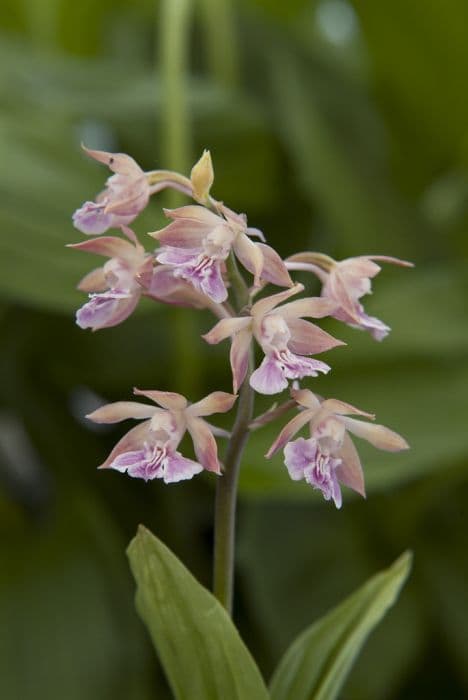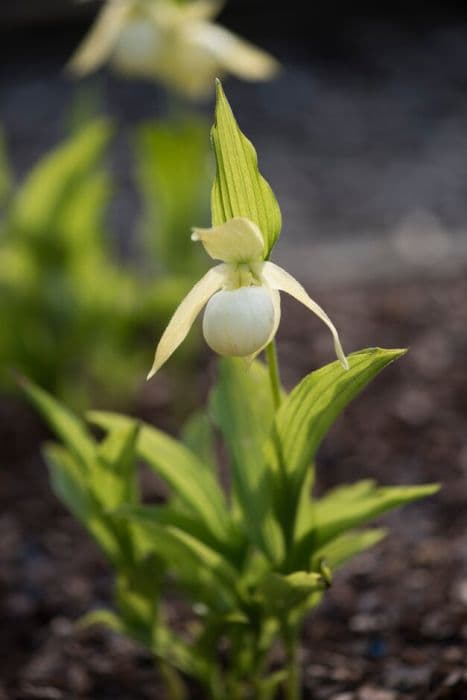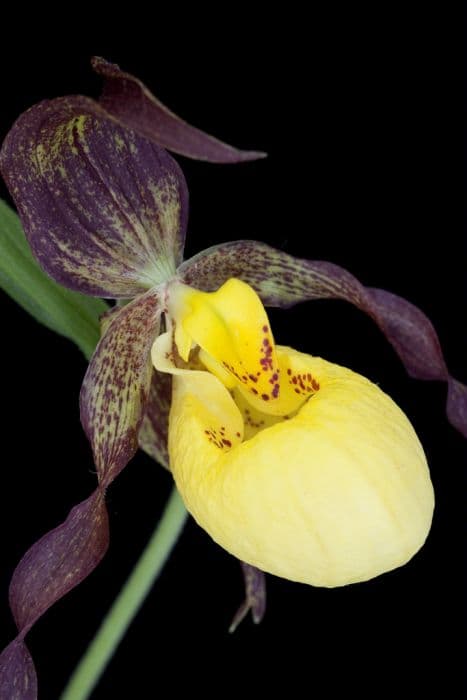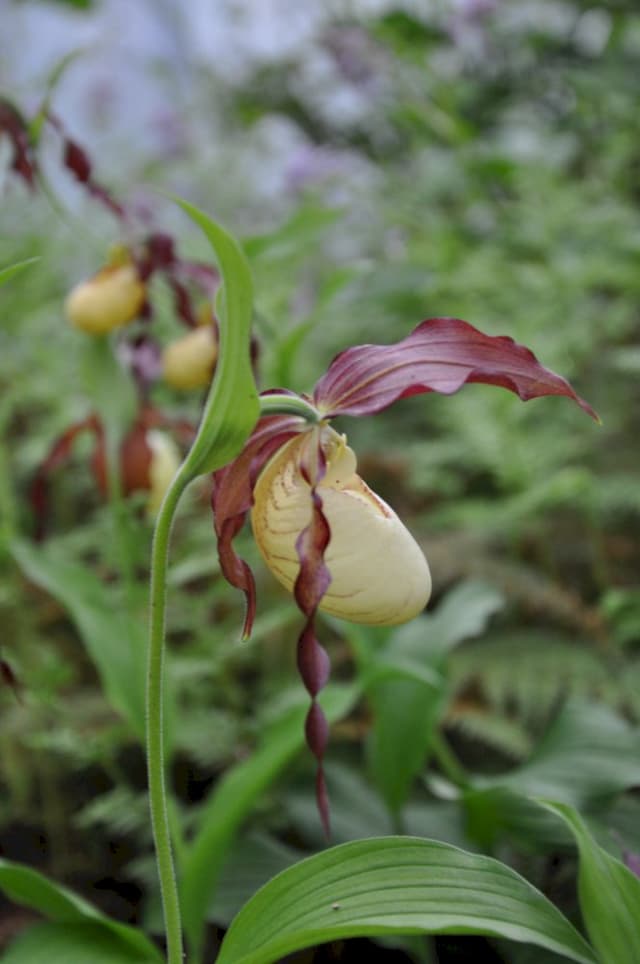Kentucky Lady's Slipper Cypripedium Gabriela gx 'Kentucky Maxi'

ABOUT
The Cypripedium Gabriela gx 'Kentucky Maxi', commonly known as the Lady's Slipper Orchid, showcases a unique and striking appearance. This orchid possesses a distinctive pouch-like lip, resembling a slipper, which is a characteristic trait of the Lady's Slipper family. The pouch is typically a vibrant shade, often ranging from deep pinks to rich purples, adding a splash of color that contrasts beautifully with the rest of the flower. Surrounding the central pouch are petals and sepals that are usually adorned with a diverse set of markings. These markings can come in various patterns, including stripes, spots, or a combination thereof, and are often in hues that complement or contrast the color of the pouch. The petals extend elegantly, contributing to the orchid's sophisticated silhouette. The leaves of the Lady's Slipper Orchid are also noteworthy, with a lush, green color and a broad, strap-like shape. The foliage provides a verdant backdrop that highlights the vibrancy of the flowers. The delicate patterns and rich colors of the plant make it a highly desirable addition to any collection, accentuating its reputation for beauty and rarity.
About this plant
 Names
NamesFamily
Orchidaceae
Synonyms
Kentucky Lady's Slipper, Gabriel's Slipper
Common names
Cypripedium Gabriela gx 'Kentucky Maxi'.
 Toxicity
ToxicityTo humans
The Cypripedium Gabriela gx 'Kentucky Maxi', commonly known as the lady's slipper orchid, is not known for being toxic to humans. No significant toxicity has been reported from ingestion or handling of this plant. Therefore, it is generally considered safe around humans with no serious consequences expected from contact or accidental ingestion.
To pets
The lady's slipper orchid is also not considered toxic to pets. It is not listed among poisonous plants for animals such as dogs and cats. As with humans, there should be no significant toxicity or serious consequences from pets ingesting or coming into contact with parts of this plant. However, it is always wise to prevent pets from ingesting plants as individual animals may have varying sensitivities, and digestive issues could occur from eating non-food items.
 Characteristics
CharacteristicsLife cycle
Perennials
Foliage type
Deciduous
Color of leaves
Green
Flower color
Varies
Height
1-2 feet (30-60 cm)
Spread
1-2 feet (30-60 cm)
Plant type
Herb
Hardiness zones
5
Native area
North America
Benefits
 General Benefits
General Benefits- Esthetic Appeal: This plant features striking flowers, which can add beauty and visual interest to gardens and landscapes.
- Habitat Support: It provides habitats and food for pollinators like bees and butterflies, supporting local ecosystems.
- Education & Conservation: Being an orchid, it can be used in educational programs to teach about plant conservation and biodiversity.
- Garden Diversity: It contributes to the biodiversity of a garden by adding a unique species that may attract a variety of wildlife.
- Stress Reduction: The act of growing and caring for plants, including orchids, can offer mental health benefits by reducing stress and promoting relaxation.
- Cultural Significance: Orchids have various cultural meanings and can be used in ceremonies or as gifts symbolizing love, luxury, and beauty.
 Medical Properties
Medical PropertiesThis plant is not used for medical purposes.
 Air-purifying Qualities
Air-purifying QualitiesThis plant is not specifically known for air purifying qualities.
 Other Uses
Other Uses- Potpourri Ingredient: The dried petals of the Lady's Slipper orchid can be added to potpourri mixes for a unique fragrance and a touch of vibrant color.
- Photography Subject: With its striking appearance, the Lady's Slipper orchid is often used by photographers as a subject for botanical and artistic photography.
- Botanical Art: Artists may use the Lady's Slipper as a model for drawing, painting, or even sculpting, contributing to botanical illustration and art collections.
- Educational Tool: Schools and educators may use the plant to teach students about orchid biology, pollination mechanisms, and plant conservation efforts.
- Fashion Inspiration: The unique shape and colors of the Lady's Slipper blossom can inspire patterns and designs in the fashion industry, including textiles and accessories.
- Wedding Decor: Due to its rare and elegant appearance, the orchid can be used in bridal bouquets and as decoration for exclusive or themed weddings.
- Literary Motif: The plant's distinctive form and rarity make it a symbolically rich element in poetry, literature, and folklore.
- Cultural Celebrations: In some regions, the Lady's Slipper orchid may be incorporated into cultural festivals or celebrations as a symbol of the area's natural heritage.
- Culinary Decoration: While not edible, the flowers can be used as a non-toxic decoration on cakes and pastries for special occasions, though they should be removed before consumption.
- Conservation Awareness: The Lady's Slipper, being rare and sometimes endangered, can be used as a mascot or emblem by conservation organizations to spread awareness about protecting native species and habitats.
Interesting Facts
 Feng Shui
Feng ShuiThe Lady Slipper Orchid is not used in Feng Shui practice.
 Zodiac Sign Compitability
Zodiac Sign CompitabilityThe Lady Slipper Orchid is not used in astrology practice.
 Plant Symbolism
Plant Symbolism- Rarity: The Cypripedium Gabriela gx 'Kentucky Maxi', commonly known as Lady's Slipper Orchid, is a rare hybrid, and its uniqueness often symbolizes rarity and value in the world of plants.
- Beauty: Lady's Slipper Orchids are renowned for their striking and unusual appearance, symbolizing beauty and the appreciation of aesthetic qualities.
- Capriciousness: With their demanding growing requirements, they can also represent capriciousness, reflecting the careful attention they need to thrive.
- Femininity: Owing to their slipper-shaped pouches and delicate form, they are often associated with femininity and the nurturing aspects of nature.
- Good Luck: In some cultures, orchids are considered to bring good luck or prosperity to their keepers, making them a symbol of good fortune.
 Water
WaterThe Lady Slipper Orchid, also known as Cypripedium, should be watered regularly to keep the soil consistently moist but not waterlogged. Water the plant once a week with about a quart of water, adjusting for climate and indoor conditions. During active growth in spring and summer, you may need to water more frequently. Watering should be reduced in the fall and winter when the plant is not growing actively. It's critical to use room temperature water and to avoid getting water on the leaves to prevent rot.
 Light
LightLady Slipper Orchids prefer bright, indirect light. An ideal spot would be near a window with a sheer curtain to diffuse direct sunlight, as direct exposure can scorch the leaves of the plant. East or west-facing windows are often great choices, where the orchid can enjoy the milder morning or afternoon sun without the harsh midday rays.
 Temperature
TemperatureFor the Lady Slipper Orchid, temperatures should be maintained between 60°F to 75°F during the day and not drop below 50°F at night. They can endure short periods of temperatures outside this range but will thrive within these parameters. Ideal growing conditions replicate a temperate climate, so avoid exposure to temperatures above 80°F, which could stress the plant.
 Pruning
PruningPruning the Lady Slipper Orchid is mainly done to remove any dead or yellowing leaves to promote healthy growth and prevent disease. The best time to prune is after flowering, usually in late summer or early fall. Cut back any spent flower stems to the base, and trim away unhealthy foliage using sterile scissors or pruning shears. Pruning should be performed as needed, usually once a year.
 Cleaning
CleaningAs needed
 Soil
SoilThe best soil mix for the Lady Slipper Orchid (Cypripedium Gabriela gx 'Kentucky Maxi') should be well-draining and rich in organic matter. A mix composed of loam, bark chips, perlite, and leaf mold is suitable. The soil pH should be slightly acidic to neutral, ranging from 5.5 to 7.0.
 Repotting
RepottingLady Slipper Orchids should be repotted every 2 to 3 years or when the growing medium begins to break down. Ensure the new pot provides adequate room for growth without being oversized.
 Humidity & Misting
Humidity & MistingLady Slipper Orchids thrive in moderate to high humidity levels, typically between 40-70%. Maintaining consistent humidity within this range is ideal for the plant's health.
 Suitable locations
Suitable locationsIndoor
Place Lady Slipper Orchid by a bright window, avoid direct sun.
Outdoor
Plant in dappled shade, shelter from extreme weather.
Hardiness zone
6-8 USDA.
 Life cycle
Life cycleThe Cypripedium Gabriela gx 'Kentucky Maxi', commonly known as the Kentucky Lady's Slipper orchid, begins its life as a dormant seed requiring symbiosis with a specific fungus to germinate. After germination, the seedling develops into a tiny protocorm, which is an early growth stage prior to true leaf development. The next stage is the growth of the first true leaves and the establishment of a small underground rhizome, characteristic of mature orchids. Over the course of several years, the Kentucky Lady's Slipper orchid reaches maturity and forms its distinctive pouch-shaped flowers, which is its reproductive stage where pollination by insects can occur. Once pollinated, the plant produces seed capsules containing numerous seeds, which are then dispersed by wind to begin the cycle anew. After flowering, the plant enters a period of dormancy where the above-ground parts die back, and it survives underground until the next growth cycle.
 Propogation
PropogationPropogation time
Spring-Early Summer
The Cypripedium Gabriela gx 'Kentucky Maxi', commonly known as Kentucky Lady's Slipper orchid, is predominantly propagated by division, which is the most popular method. This should be done in late summer or early fall when the plant is not actively growing. To propagate by division, carefully dig up the plant and gently separate the rhizomes, ensuring each division has at least one growth bud. These divisions can then be replanted in a well-draining mix, keeping the growing point just at the soil surface. It is critical to maintain high humidity and appropriate temperatures for the orchids to establish well after division.









